Nodal anatomy refers to the study of the structure and function of nodes of plants, which are the points on a stem where leaves, branches, and buds arise. This includes the examination of the internal and external features of nodes, such as the vascular tissue, meristems, leaf gaps and leaf traces. Understanding nodal anatomy is important for comprehending the growth and development of angiosperms and for identifying their different parts and structures. The present articles discusses the features of Nodal Anatomy in flowering plants with suitable examples.
Nodal Anatomy
Anatomy of Nodal and Inter-nodal Region are Different
The stem of plants is differentiated into nodes and internodes. The anatomical features of the nodal region are quite different from that of the inter-nodal region. This anatomical difference is due to the presence of Vascular Supply to the leaves and branches from the main vascular cylinder of the stem.
Nodal Region of Higher Plants Posses Leaf Gaps and Leaf Traces
Each leaf that originates from the node, of higher plants possesses vascular tissue and these vascular tissues of the leaves are connected to that of the stem. A vascular strand that extends between the vascular cylinder of stem and the base of the leaf is called Leaf Trace or Foliar Trace.
Even if the leaf trace possesses both xylem and phloem, the relative amount of xylem will be more in the leaf trace than phloem. Moreover, the proximal portion, (portion near the vascular cylinder of the stem) contains only the xylem. Whereas, the distal end of the leaf trace (near to the leaf base) contains both xylem and phloem.
Leaf trace helps to transport water and minerals from the xylem to the leaf lamina for photosynthesis. The circulation of photosynthetic products from the leaf lamina to the phloem of the stem is also facilitated by the phloem strands in the leaf traces.
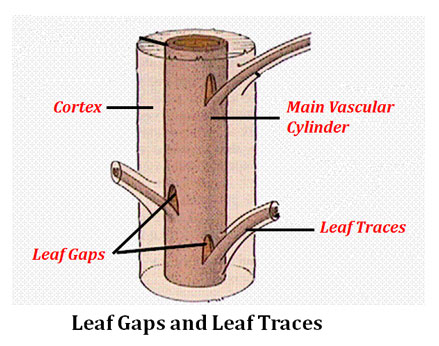
Even though the leaf trace is an extension of the vascular cylinder to the leaf, they are not a continuous supply from the main vascular cylinder. In the vascular cylinder just above the point of departure of the leaf trace, a small parenchymatous patch occurs. This parenchymatous region between the main vascular cylinder and the leaf trace is called Leaf Gap or Lacuna.
The leaf gap is situated on the upper side of the leaf trace. In a cross-section through the leaf gap region, it is visualized as a zone of parenchyma inside the vascular cylinder. Due to the presence of leaf gap, the cortical parenchyma becomes continuous with that of pith during the early stages of secondary growth.
Nodes are classified on the basis of Number of Leaf Gaps and Leaf Traces
The number and nature of leaf gaps and leaf traces varies in different plants. On the basis of the number of leaf gaps and leaf traces, THREE main nodes are described in Angiosperms.
(1). Unilacunar
(2). Trilacunar
(3). Multilacunar
| You may also like NOTES in... | ||
|---|---|---|
| BOTANY | BIOCHEMISTRY | MOL. BIOLOGY |
| ZOOLOGY | MICROBIOLOGY | BIOSTATISTICS |
| ECOLOGY | IMMUNOLOGY | BIOTECHNOLOGY |
| GENETICS | EMBRYOLOGY | PHYSIOLOGY |
| EVOLUTION | BIOPHYSICS | BIOINFORMATICS |
(1). Unilacunar Node
A unilacunar node possesses only a single leaf gap to a leaf. Each leaf may possess one or two or three leaf traces.
Example: Nerium, Lantana camara, Justicia (with one gap and one trace); Clerodendron splendens (two traces); Chenopodium album and Withania somnifera (with one gap and three traces).
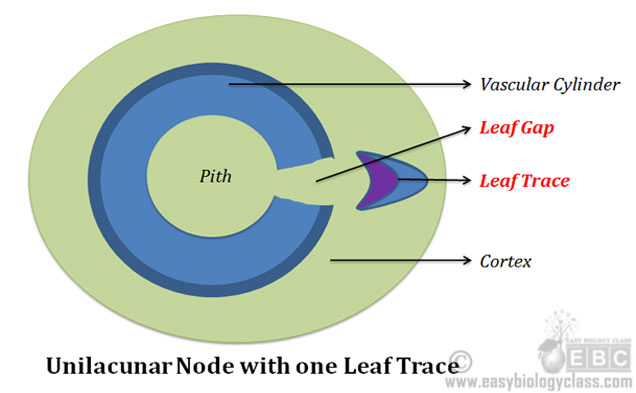
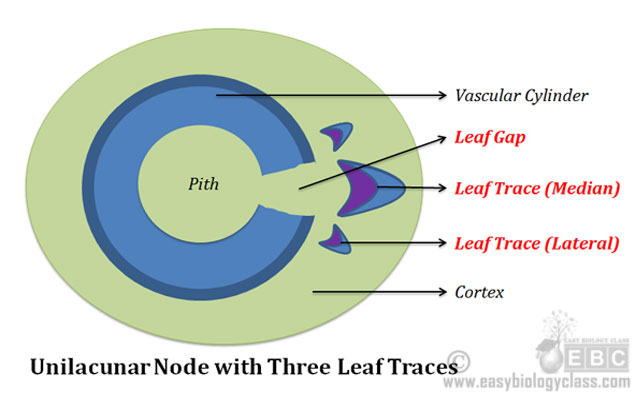
(2). Trilacunar Node
A trilacunar node possesses three leaf gaps and three leaf traces. Among these three leaf traces, the middle one (median) will be larger and the other two laterals will be smaller.
Example: Azadirachta
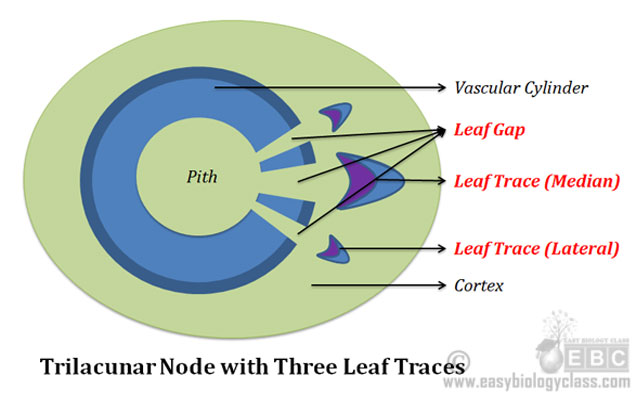
(3). Multilacunar Node
A multilacunar node possesses many leaf gaps and many leaf traces. Among the many traces, the median one (middle) will be larger and all others will be smaller.
Example: Polygonum plebeium, Coriandrum sativum, Aralium
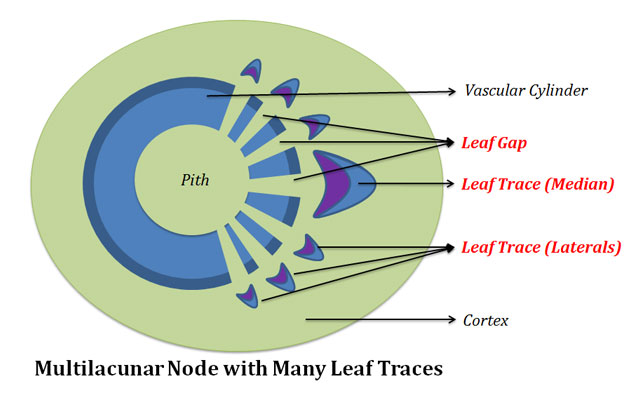
Nodal Anatomy shows the Phylogenetic Primitiveness or Advancements
A unilacular node with two traces is considered to be the most primitive type of node among Angiosperms. One trace unilacunar node and trilacunar node is considered to be evolved from a trilacunar condition. During the evolution of nodal region, fusion, deletion and additions of leaf traces have occurred in the remote past. Apart from the phylogenetic significance, the nodal anatomy is a good taxonomic character used in the systematics of higher plants.
Key questions
1. What is leaf trace? What is its significance?
2. What is Leaf gap? Explain the structure of leaf gap.
3. Explain unilacunar node with examples and diagram.
4. Explain the anatomy of trilacunar node with examples and diagram
5. Describe the structure of a multilacunar node in plants.
6. With suitable diagrams and examples, write an essay on the anatomy of the nodal region in higher plants. What are the evolutionary significances of nodal anatomy?
| You may also like... | ||
|---|---|---|
| NOTES | QUESTION BANK | COMPETITIVE EXAMS. |
| PPTs | UNIVERSITY EXAMS | DIFFERENCE BETWEEN.. |
| MCQs | PLUS ONE BIOLOGY | NEWS & JOBS |
| MOCK TESTS | PLUS TWO BIOLOGY | PRACTICAL |

Super for me notes